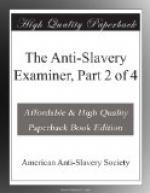After the congregation had resumed their seats, the worthy Chairman addressed us briefly in behalf of the congregation, saying, that it was incumbent on him to convey to us the unanimous expression of sympathy on the part of this numerous assembly in the object of our visit to the island. We might regard it as an unfeigned assurance that we were welcomed among them, and that the cause which we were laboring to promote was dear to the hearts of the people of Antigua.
This was the testimonial of an assembly, many of whom, only three years before, were themselves slaveholders. It was not given at a meeting specially concerted and called for the purpose, but grew up unexpectedly and spontaneously out of the feelings of the occasion, a free-will offering, the cheerful impulsive gush of free sympathies. We returned our acknowledgments in the best manner that our excited emotions permitted.
LAYING THE CORNER STONE OF A WESLEYAN CHAPEL.
The corner stone of a new Wesleyan Chapel was laid in St. John’s, during the district meeting. The concourse of spectators was immense. At eleven o’clock religious exercises were held in the old chapel. At the close of the service a procession was formed, composed of Wesleyan missionaries, Moravian ministers, clergymen of the church, members of the council and of the assembly, planters, merchants, and other gentlemen, and the children of the Sunday and infant schools, connected with the Wesleyan Chapel.
As the procession moved to the new site, a hymn was sung, in which the whole procession united. Our position in the procession, to which we were assigned by the marshal, and much to our satisfaction, was at either side of two colored gentlemen, with whom we walked, four abreast.
On one side of the foundation a gallery had been raised, which was covered with an awning, and was occupied by a dense mass of white and colored ladies. On another side the gentlemen of the procession stood. The other sides were thronged with a promiscuous multitude of all colors. After singing and prayer, the Hon. Nicholas Nugent, speaker of the house of assembly, descended from the platform by a flight of stairs into the cellar, escorted by two missionaries. The sealed phial was then placed in his hand, and Mr. P., a Wesleyan missionary, read from a paper the inscription written on the parchment within the phial. The closing words of the inscription alluded to the present condition of the island, thus: “The demand for a new and larger place of worship was pressing, and the progress of public liberality advancing on a scale highly creditable to this FREE, enlightened, and evangelized colony.” The Speaker then placed the phial in the cavity of the rock. When it was properly secured, and the corner stone lowered down by pullies to its place, he struck three blows upon it with a mallet, and then returned to the platform. The most eager curiosity was exhibited on every side to witness the ceremony.




